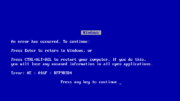Sometimes obsolete technology has a way of sticking around. Take a look at this amazon listing. This is a printer that is still made, and essentially identical to one you might have had in the late 1980s. Obsolete yes, but far from gone.
Dot Matrix Technology
Dot matrix technology was very popular with hobbyists and small businesses in the 1970s and 1980s. It was less expensive than other competing tech and while it wasn’t terribly attractive to look at the final piece, it was legible enough.

Dot matrix technology was an evolution of line printer technology. In the 1960s, the fastest printers used a line of electronic solenoids that spread all the way across the page. These solenoids were tiny, less than a millimeter in size. They fired together and an entire line of dots was formed. The paper was then advanced a tiny amount and the whole process repeated. Even by today’s standards it was a fast system, kicking out 10-15 pages a minute.
Line printers worked well, but they were huge and expensive. Along the way, enterprising inventors took the same idea and instead of stacking about 600 solenoids across a page, they stacked 7 solenoids on top of each other and put the entire thing in a moving carriage. This was a lot slower but the quality was about the same and it was a lot, lot cheaper.

What you see above you is one of the first commercially successful dot matrix printers. It was made by a company called Centronics, which faded into history almost completely. For a while printer cables were called “Centronics cables” but even that stopped by the early 1990s.
Dot matrix printers improved throughout the 1980s and 1990s but eventually they were displaced. First, consumer-grade laser printers like HP’s truly horrible Laserjet 5L came in, then inkjet printers took over. Inkjet printers take the dot-matrix idea and use tiny jets of ink instead of impact solenoids. Those jets can be much much smaller and lead to much better print quality and color printing.
Color dot-matrix

There are actually color dot-matrix printers like Epson’s LX-300, pictured above. They never really took off. The dots are too big to form continuous tones. Also, because they use a ribbon, you run out of all colors at once. An advantage of inkjet printers is that you can replace the color tanks at different rates if you need to.
The amazing staying power of dot matrix printers
There are still several dot matrix printers on the market. The most successful of all is the Okidata Microline 321.

Okidata actually had the first dot matrix printer in 1968 and by the early 1990s this printer was everywhere. Literally everywhere. I think you could have built buildings out of them considering how many of them there were at one point.
The printer stayed popular due to its compatibility with Quicken and several medical office billing programs. For companies that needed to use multipart forms, a laser printer was a poor substitute. This printer was built to take years of abuse. They worked so well that most of them turned yellow from age, like this specimen recently sold on eBay:

Will we ever be truly rid of the dot matrix printer?
It’s taken time, but I think you’re starting to see fewer dot matrix printers out there. A few factors have conspired to get rid of the last one. First of all, Windows XP, once the standard of the computing world, is now so totally past end of life that it’s almost impossible to use. This has led companies that were slow to upgrade into the 21st century. They’ve had to upgrade software to work with Windows 10, and that also means they can finally upgrade the printer too.
At the same time, paperless forms are finally taking off after about 40 years of trying. With everyone having a phone, and with PDF technology available to all (the patents were opened up over a decade ago) it’s easier to create forms that can be electronically signed.
The last uses of dot-matrix technology are weird, fringe cases that would never have been thought of. Tattoo parlors use them for … something. I don’t know what. But they’re still out there.
It’s just that I think we can finally say, they’re obsolete.





